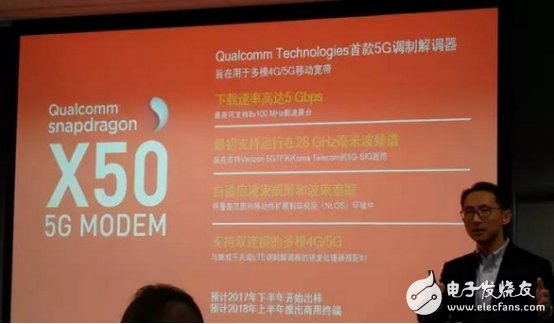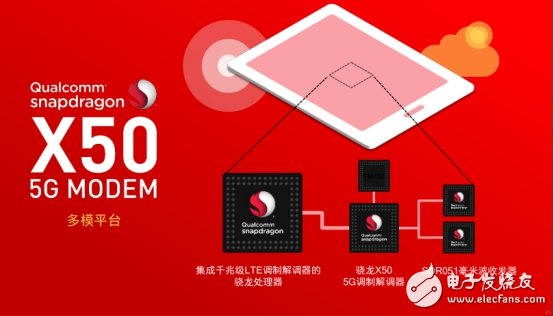What is the layout of Qualcomm on the 5G technology road?
The polarization code pushed by Huawei and other Chinese companies defeats the LDPC code of the US main push and the Turbo code of the French main push, becoming the control channel coding scheme for the 5G eMBB scene on the short code. For a time, this news has set off a great discussion in China. This is indeed a breakthrough for Chinese communication companies in 5G technology, and it also helps to break the monopoly of 5G standards in Europe and America. At the Qualcomm Media Salon, two parts were introduced: one involved Gigabit LTE. The new modem (Xianlong X50 5G modem); the second part focuses on the IoT field. Qualcomm also has new LTE modem products/technologies.
Before talking about 5G, let's talk about it from 3G. 3G technologies include CDMA2000, WCDMA and TD-SCDMA. CDMA2000 is dominated by Qualcomm, while WCDMA is dominated by Nokia and Ericsson (they all claim to have 20-30% of WCDMA patents, and Qualcomm seems to have only 10%) TD-SCDMA is dominated by China (mainly ZTE, Huawei, China Mobile, etc.) and has certain independent intellectual property rights (TD-SCDMA still partially adopts CDMA technology). However, the former two occupy the largest market, and TD-SCDMA is limited to the Chinese market. Although the latter two do not seem to have a direct relationship with Qualcomm, but Qualcomm masters the core technology of CDMA, so whether it is Ericsson or Nokia, or Chinese manufacturers using TD-SCDMA technology, it seems that they need to pay patencies to Qualcomm.

In the 4G era, it is FDD-LTE and TD-LTE. Although China-led TD-LTE has independent intellectual property rights, in fact, more than 90% of the patents of the two systems are common. According to some data from the previous Qualcomm monopoly case, Qualcomm still has a lot of LTE patents (including TD-LTE and FDD-LTE). "After the investigation and recognition of the National Development and Reform Commission, Qualcomm can still charge 3.5% of TD-LTE technology. Royalties".
It can be said that in the 3G technology, Qualcomm dominates. In terms of 4G technology, although Qualcomm has suffered an impact, on the market side, Qualcomm is still the hegemon. So, in terms of 5G technology, what is the layout of Qualcomm?
éªé¾™X50
According to reports, the Xiaolong X50 5G modem will initially support the operation of the millimeter wave (mmWave) spectrum in the 28GHz band, which will be in line with the 5G-SIG specifications of Verizon 5GTF and Korea Telecom. Although millimeter waves have the advantage of high transmission rate, their signals are easily attenuated and it is difficult to penetrate obstacles. However, Qualcomm said that multi-antenna arrays can be used with multiple-input multiple-output (MIMO) antenna technology with adaptive beamforming and beam tracking to extend coverage and mobility to non-line-of-sight (NLOS) environments. Achieve stable and continuous mobile broadband communications. By supporting 8&TImes; 100MHz carrier aggregation, the Opteron X50 5G modem can support peak download speeds of up to 5Gbps per second.

In addition, the Snapdragon X50 5G modem can also be used with the Snapdragon X16 Gigabit LTE modem to support dual-connected multimode 4G/5G networks. The Snapdragon X16 provides a wide-area overlay network for early 5G networks, so it Will become an important pillar of the 5G mobile experience. The Snapdragon X50 5G platform will include a modem, SDR051 millimeter wave transceiver and a supporting PMX50 power management chip. The Xiaolong X50 5G modem is expected to begin sampling in the second half of 2017. The first commercial products to integrate the Opteron X50 5G modem are expected to be available in the first half of 2018.
"5G technology is not produced out of thin air, but the product of 4G LTE and other communication technologies has been developed in parallel to a certain stage. Even if the 5G era is reached, it will still be deployed with 4G for a long time." Qualcomm product market Senior Director Shen Lei said: "From the current point of view, 4G still has an evolution period of 10 to 15 years or even longer, Qualcomm will actively promote the parallel development of LTE and 5G."
Gigabit LTE chip Snapdragon X16
Based on the advanced 14nm process, the Snapdragon X16 LTE modem is the first commercial Gigabit LTE chip in the mobile industry. The Snapdragon X16 supports up to 4&TImes across the FDD and TDD spectrum; 20 MHz downlink carrier aggregation (CA) and 256 -QAM delivers "as fiber-like" LTE Category 16 download speeds up to 1 Gbps; it also delivers up to 150 Mbps upstream speeds by supporting up to 2x20 MHz uplink carrier aggregation and 64-QAM.

In addition, the Snapdragon X16 is also equipped with the Qualcomm RF360 QET4100 envelope tracker, which significantly improves LTE power consumption through the world's first LTE FDD and LTE TDD 40MHz envelope tracking solutions. The Snapdragon X16 LTE modem, WTR5975 and QET4100 are designed and optimized together as a single system to support fast downloads, agile application performance, and enhanced thermal efficiency and optimized power consumption. The new chipset is designed to support a wide range of connectivity platforms from smartphones, tablets and mobile computing terminals to automobiles, drones and virtual reality devices.
Qualcomm said that thanks to the Gigabit LTE speed of the Snapdragon X16 LTE modem, users will be able to enjoy the benefits of its breakthrough features, such as real-time delivery of 360-degree virtual reality content, a new audio-visual entertainment experience (fast cache) Ultra-high-fidelity music and movies), instant app (no need to download and install), faster and more seamless access to cloud apps and services. It will also make cloud storage or will have comparable read speeds to local flash.
New narrowband LTE technology for the Internet of Things
According to market research institutions, there will be more than 5 billion IoT connections based on cellular technology by 2025, which is clearly a very large market. Different from mobile terminal devices such as smart phones, the IoT market has relatively low requirements for mobility and data transmission speed. Therefore, the current application in the Internet of Things market is mainly 2.5G/3G networks. Although LTE Cat-1/Cat-4 and other networks are also used, in Qualcomm's view, the future two narrowband LTE technologies standard LTE Cat-M1 (machine type communication) and LTE Cat-NB1 (NB-IoT) 3GPP Release The 13 standard will become the mainstream technology for IoT applications. In particular, Cat-NB1, as early as the RAN plenary meeting in September 2015, has been identified by 3GPP as the standard for narrowband cellular Internet of Things.

The advantage of narrowband LTE technology is that it can utilize existing LTE infrastructure and spectrum, which can further reduce the complexity of terminal and core networks, achieve lower power consumption and extend battery life, and achieve deeper coverage through redundant transmission. LTE Cat-M1 technology uses 1.4MHz bandwidth, widely used for Internet connection of Internet of Things applications, including voice communication, the highest data transmission rate of 1Mbps; LTE Cat-NB1 is also called NB-IoT, the required bandwidth is about 200KHz It mainly transmits low-traffic data at a rate below 100Kbps.
Earlier this year, Qualcomm introduced the MDM9x07 series of modems (based on Cat4/Cat1), which has been adopted by more than 60 vendors and more than 100 products are in the process of design and launch. Next, Qualcomm will launch the Cat-M1 chip MDM9206 for the IoT market, and this product will also support NB-IoT through software upgrades. According to Qualcomm, the MDM9206 has been designed by most of the industry's leading OEMs and module manufacturers, and the MDM9206-based module is expected to be released in early 2017.
At present, there are still many challenges in the successful application of Gigabit LTE chips on mobile phones, such as the need to support 4 & TImes; 4 MIMO, that is, the mobile phone requires four antennas (in addition to a WiFi antenna), and currently the mobile phones are mostly two The antenna (Samsung S7 is four antennas), coupled with the metal casing of the mobile phone and the interference of the user holding the handshake, poses a high challenge for mobile phone manufacturers. However, Qualcomm said that the Snapdragon X16 can support multi-band WiFi (including 2.4GHz, 5GHz, 60GHz), and can realize the LTE/5G and WiFi integrated antenna. However, for 5G phones, more root antennas may be needed.
Integrated Performance:
The major products can be divided into two series, Lead acid and Gel, of which gel batteries is
more outstanding: wide temperature range, good recovery ability after over-discharge,long cycle life.
1) Patent structure: Convenient wire type structure for connection(Patent No. ZL200720045887.1
and L200720037066.3), achieves a true underground installation, avoids the pole corrosion.
2) Recovery performance: adopt special alloys and lead paste formulations, make a low self-discharge
rate, good deep discharge tolerance, and strong recover capability.
3) Charging efficiency: using imported low resistance raw materials and advanced process,
make a small internal true tolerance: wide temperature range(lead-acid: 25-50 C, and gel: -35-60 C),
suitable for indoor and outdoor use in varies environments.
4) High and low temperature tolerance:wide temperature range(lead-acid:-25-50 and gel:-35-60),
suitable for indoor and outdoor use in varies environments.
5) Long cycle-life: Using multiple rare-earth alloy of independent intellectual propets, nanoscale
fumed silica imported from Germany as base materials,and electrolyte of nanometer colloid all by
independent research and development.The grid is corrosion resistant,and without electroyte
stratification in electrol.
Solar Battery,210mm Solar Battery,Gel Battery
Wuxi Sunket New Energy Technology Co.,Ltd , https://www.sunketsolar.com
